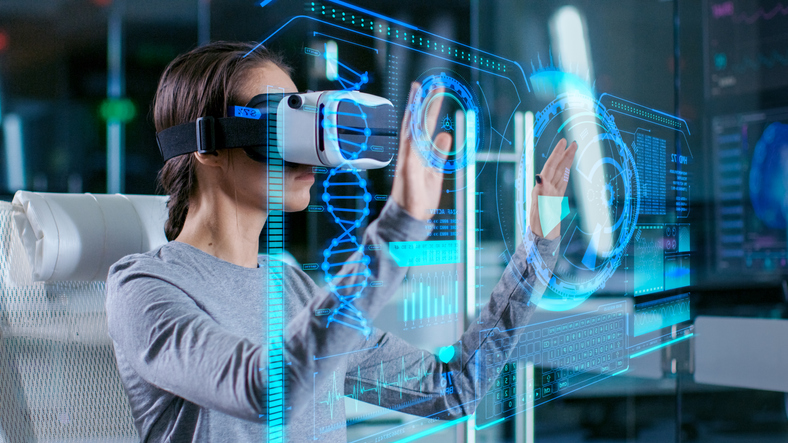The visual aids, AR and VR, therapeutic and educational, are fully prepared to play a central part in more aspects of care delivery.
The scenarios where physical contact must be limited are increasing as the pandemic continues and providers are searching for virtual and augmented reality tools to facilitate a connection with patients, while supporting personalization in care.
The technology VR simulates a fully immersive experience whereas the technology AR can incorporate sensory elements in a real-world setting (think Pokemon GO).
Dr. Samuel Browd is a professor of neurological surgery at the University of Washington and a co-founder at Proprio, a surgical-navigation technology company. He stated that until recently, the platforms were limited to niche applications, such as for educating patients before a surgery, however, they are growing rapidly as clinical teams adapt to the norms of COVID-19.
The estimate that the market for AR and VR in healthcare is going to reach by 2026, is a whopping $2.4 billion, according to Allied Market Research. Cases where these technologies are utilized keep on expanding and now include pain management, memory care, medical training and others.
A principal in Deloitte’s healthcare practice, Jennifer Radin, stated that there are unlimited use cases for both AR and VR technology if we consider that the future in healthcare is for it to be provided anywhere the individual might be.
Below are some ways these immersive technologies are emerging into medicine.
VR Provides Medical Immersion for a Range of Patient Needs
Jeffrey Becker, a senior healthcare analyst at Forrester claims that healthcare consumers have already been exposed to VR and AR. An easy, yet effective entry point and example is the ability to ”try on” glasses via retailers’ webistes.
“AR is beginning to be used as a patient-facing engagement tool,” Becker says, noting that some companies offer similar solutions in the aesthetic medicine and orthodontia markets. These solutions give users the sense of the intended progress or result of a procedure.
As patients continue to be in lockdown, remaining in isolation, organizations in the healthcare industry could consider launching or even increasing VR programs targeted towards self-guided rehabilitation exercises and addressing chronic pain, says Adriaan Louw, a co-founder of the International Spine & Pain Institute. Louw is also an adjunct professor at several schools, including the University of Nevada in Las Vegas.
Louw continues by saying that in the future the norm will most probably be receiving care virtually or even hybrid models of in-person and vritual. “Forward-thinking systems should consider having a fleet of VR headsets at their disposal for a variety of applications.”
For instance, in the future, a VR headset, could be used on a physical therapy patient and once thoroughly cleaned be given to a mother-to-be in the labor and delivery room to serve as a visual distraction.
AR and VR for Surgery Deliver Preparation and Efficiency
It is not only patients needing care that are going to reap the benefits of VR and AR technologies. More and more, AR and VR are being utilized in operating rooms and even in classrooms to aid surgeons in their preparation for the challenges ahead in their field.
The changes AR and VR are making in the ways surgeries are now performed are profound, mentioned Radin. Surgeons using AR and VR can go through the organs they are about to operate on from checklists.
The next focus future technology investments will have will be on creating efficiencies in delivering complex care, Browd says.
Up to now the information a patient had about their upcoming surgery was from the doctor showing them an X-ray and telling them what they were about to do. With these new technologies, patients can see a 3D model of their upcoming surgery and even how things will look like afterwards. Browd also notes that platforms’ real paradigm-shifting value will be using the technology to improve surgery while it’s in progress.
“Once a surgeon experiences AR intraoperatively, they have a hard time conceptualizing how they would ever stay with the status quo of today”, says Browd.
Expansion of VR Programs in Healthcare by Addressing Disparities
For a more widespread use of AR and VR in the healthcare industry, access to 5G networks and 5G-enabled devices are a major hurdle, Becker says. He continues by adding that some organizations could fall behind, in comparison to their competition, due to general disparities in resources.
As of now there has not yet been a strong illustration for cost savings when adopting the use of AR and VR in virtual care and chronic disease mananagement, but as more data and research comes to light there could be a shift, Becker says.
Louw is confident that the financial benefits will be understood.
“Consumers are going to notice the superior outcomes and cost savings made possible by virtual care platforms, VR included, and they will probably begin to purchase these programs, making them a part of routine care plans,” Louw says.

